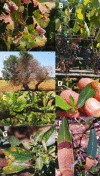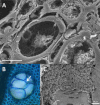Xylella fastidiosa: an examination of a re-emerging plant pathogen
- PMID: 28742234
- PMCID: PMC6637975
- DOI: 10.1111/mpp.12585
Xylella fastidiosa: an examination of a re-emerging plant pathogen
Abstract
Xylella fastidiosa is a Gram-negative bacterial plant pathogen with an extremely wide host range. This species has recently been resolved into subspecies that correlate with host specificity. This review focuses on the status of X. fastidiosa pathogenic associations in plant hosts in which the bacterium is either endemic or has been recently introduced. Plant diseases associated with X. fastidiosa have been documented for over a century, and much about what is known in the context of host-pathogen interactions is based on these hosts, such as grape and citrus, in which this pathogen has been well described. Recent attention has focused on newly emerging X. fastidiosa diseases, such as in olives.
Taxonomy: Bacteria; Gammaproteobacteria; family Xanthomonadaceae; genus Xylella; species fastidiosa.
Microbiological properties: Gram-negative rod (0.25-0.35 × 0.9-3.5 μm), non-flagellate, motile via Type IV pili-mediated twitching, fastidious.
Host range: Xylella fastidiosa has a broad host range that includes ornamental, ecological and agricultural plants belonging to over 300 different species in 63 different families. To date, X. fastidiosa has been found to be pathogenic in over 100 plant species. In addition, it can establish non-symptomatic associations with many plants as a commensal endophyte. Here, we list the four distinct subspecies of X. fastidiosa and some of the agriculturally relevant diseases caused by them: X. fastidiosa ssp. fastidiosa causes Pierce's disease (PD) of grapevine (Vitis vinifera); X. fastidiosa ssp. multiplex causes almond leaf scorch (ALS) and diseases on other nut and shade tree crops; X. fastidiosa ssp. pauca causes citrus variegated chlorosis (CVC) (Citrus spp.), coffee leaf scorch and olive quick decline syndrome (OQDS) (Olea europaea); X. fastidiosa ssp. sandyi causes oleander leaf scorch (OLS) (Nerium oleander). Significant host specificity seemingly exists for some of the subspecies, although this could be a result of technical biases based on the limited number of plants tested, whereas some subspecies are not as stringent in their host range and can infect several plant hosts.
Disease symptoms: Most X. fastidiosa-related diseases appear as marginal leaf necrosis and scorching of the leaves. In the case of PD, X. fastidiosa can also cause desiccation of berries (termed 'raisining'), irregular periderm development and abnormal abscission of petioles. In olive trees affected with OQDS, leaves exhibit marginal necrosis and defoliation, and overall tree decline occurs. Plants with ALS and OLS also exhibit the characteristic leaf scorch symptoms. Not all X. fastidiosa-related diseases exhibit the typical leaf scorch symptoms. These include CVC and Phony Peach disease, amongst others. In the case of CVC, symptoms include foliar wilt and interveinal chlorosis on the upper surfaces of the leaves (similar to zinc deficiency), which correspond to necrotic, gum-like regions on the undersides of the leaves. Additional symptoms of CVC include defoliation, dieback and hardening of fruits. Plants infected with Phony Peach disease exhibit a denser, more compact canopy (as a result of shortened internodes, darker green leaves and delayed leaf senescence), premature bloom and reduced fruit size. Some occlusions occur in the xylem vessels, but there are no foliar wilting, chlorosis or necrosis symptoms . USEFUL WEBSITES: http://www.piercesdisease.org/; https://pubmlst.org/xfastidiosa/; http://www.xylella.lncc.br/; https://nature.berkeley.edu/xylella/; https://ec.europa.eu/food/plant/plant_health_biosecurity/legislation/emergency_measures/xylella-fastidiosa_en.
Keywords: Pierce's disease; citrus; grapevine; olive; tyloses; xylem.
© 2017 BSPP AND JOHN WILEY & SONS LTD.
Figures



References
-
- Abbott, A. (2015). Italian scientists under investigation after olive‐tree deaths. Nature, doi: 10.1038/nature.2015.19078 . - DOI
-
- Aguero, C.B. , Uratsu, S.L. , Greve, C. , Powell, A.L.T. , Labavitch, J.M. , Meredith, C.P. and Dandekar, A.M. (2005) Evaluation of tolerance to Pierce's disease and Botrytis in transgenic plants of Vitis vinifera L. expressing the pear PGIP gene. Mol. Plant Pathol. 6, 43–51. - PubMed
-
- Aldrich, T.J. , Rolshausen, P.E. , Roper, M.C. , Reader, J.M. , Steinhaus, M.J. , Rapicavoli, J. , Vosburg, D.A. and Maloney, K.N. (2015) Radicinin from Cochliobolus sp. inhibits Xylella fastidiosa, the causal agent of Pierce's Disease of grapevine. Phytochemistry, 116, 130–137. - PubMed
-
- Almeida, R.P.P. (2016) ECOLOGY. Can Apulia's olive trees be saved? Science, 353, 346–348. - PubMed
-
- Almeida, R.P.P. and Nunney, L. (2015) How do plant diseases caused by Xylella fastidiosa emerge? Plant Dis. 99, 1457–1467. - PubMed
Publication types
MeSH terms
LinkOut - more resources
Full Text Sources
Other Literature Sources
Research Materials
Miscellaneous

